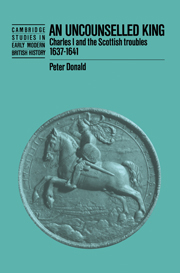Book contents
- Frontmatter
- Contents
- Preface
- List of abbreviations
- Note on the text
- 1 The king and his counsel
- 2 The king's troubles
- 3 The King's Commissioner
- 4 The king and war
- 5 A British problem
- 6 Parliaments and war
- 7 Projected settlements
- 8 An uncounselled king
- Bibliography of manuscript and printed primary sources
- Index
- Cambridge Studies in Early Modern British History
3 - The King's Commissioner
May – December 1638
Published online by Cambridge University Press: 20 October 2009
- Frontmatter
- Contents
- Preface
- List of abbreviations
- Note on the text
- 1 The king and his counsel
- 2 The king's troubles
- 3 The King's Commissioner
- 4 The king and war
- 5 A British problem
- 6 Parliaments and war
- 7 Projected settlements
- 8 An uncounselled king
- Bibliography of manuscript and printed primary sources
- Index
- Cambridge Studies in Early Modern British History
Summary
However much welled up in Scotland outwith the king's control, Charles had a part in provoking the course of actions up to the signing of the Covenant; his continuing failure thereafter to be responsive to the problems of his Scottish government reaped a crisis of ever greater proportions. Neither his policy nor his style of rule was suited to difficult times. The decision to go to arms was as ill-fated as the liturgy, although in a way as inevitable. The king of three kingdoms looked everywhere for his strength; but crises in three kingdoms would follow one after the other.
From his appointment in May 1638 through to the general assembly at Glasgow and its immediate aftermath at the end of the same year, the Marquis of Hamilton as the King's Commissioner tried to serve Charles's best interests. The task was tension-ridden from the outset. The king was to rule well over his subjects; but, for many Scottish subjects, their king's rule for the preservation of religion and liberties had come to mean something rather different from Charles's own vision.
Hamilton had first to satisfy Charles. That was no mean job, given the king's high expectations and the run of personal and factional intrigue wooing his sympathies. Hamilton had at least an advantage in his closeness of birth, matched by a companionship with Charles that few others apart from the queen enjoyed. Nevertheless he was vulnerable.
- Type
- Chapter
- Information
- An Uncounselled KingCharles I and the Scottish Troubles, 1637–1641, pp. 78 - 118Publisher: Cambridge University PressPrint publication year: 1990



